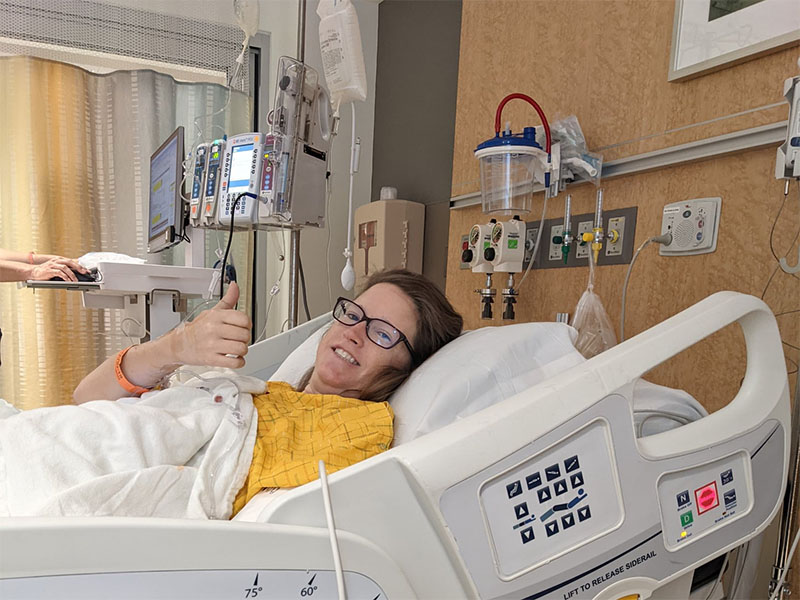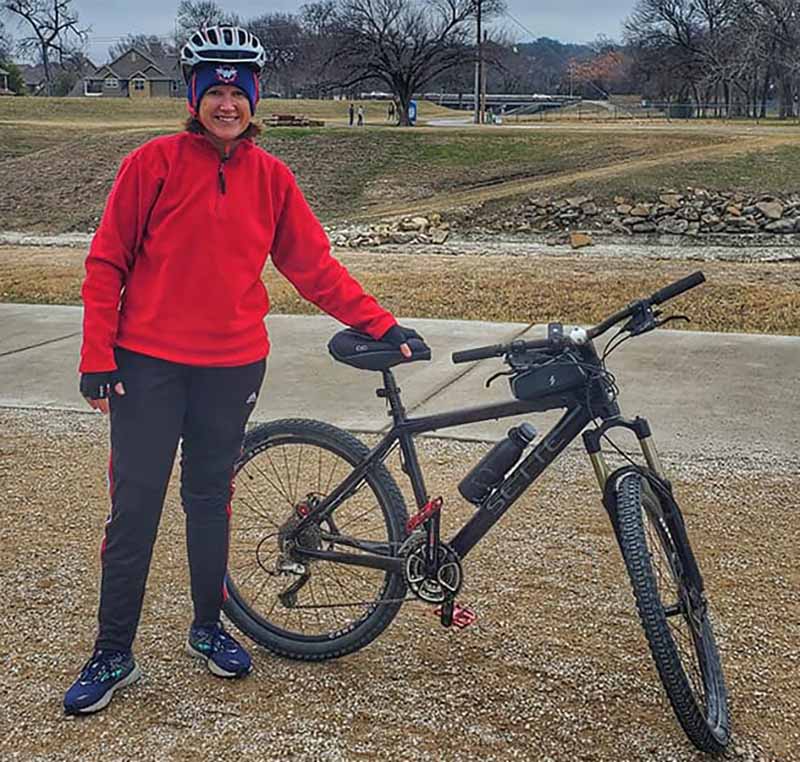Not just bad shoes and sore muscles – she had peripheral artery disease
By Suzanne Marta, American Heart Association News

Abigail Dudek celebrated her 40th birthday in Las Vegas a few months ago, grateful to go hiking and cycling without pain for the first time in more than two years.
The problem started in April 2018. As her county's 911 public educator, she spent most the day on her feet at a public event. Although she was accustomed to achy feet, this time it felt different.
"It was like a hard pea in between my toes on my right foot," she said. "It didn't come on gradually, it was just suddenly there."
A week later, she consulted with a podiatrist. He said Abigail likely had Morton's neuroma, a thickening of the tissue that surrounds a nerve leading to the toes. The treatment seemed simple: wear more supportive shoes.
Abigail did, but her symptoms only got worse.
An active cyclist and hiker, she felt her calf and shin throb during exercise, relenting only when she stopped. Her foot would go numb when she laid down.
Months later, Abigail saw an orthopedist. He suggested the problem could be very tight muscles. The new treatment involved six months of physical therapy.
Still, Abigail said, "nothing seemed to help."
By mid-2019, she was having trouble sleeping. Her right foot would get unusually cold and turn white when she laid down. No matter how warm it was, she needed thick winter socks to keep her feet warm.
"I would have to hang my leg off the bed to get any relief," she said.
The pain was too much for hiking, but Abigail continued cycling. It became an outlet for navigating the emotional toll of her frustration and the pain. She also realized another clue.
"My foot would go completely numb and I'd have sharp pain in my calf and upper thigh, but it would go away when I stopped and rested," she said.
Abigail's hunt for answers continued. A neurologist said she had something called complex regional pain syndrome. Medication for that didn't help.
In early 2020, she returned to the orthopedist, wondering if the problem stemmed from a pinched nerve in her back. The orthopedist ruled that out, but eventually referred her to a sports medicine specialist in Dallas, about an hour drive from her home in Fort Worth.
The new doctor felt her left leg. Then the right. Then he said, "I can feel a temperature difference. I think you need to see the vascular team."
Four weeks later, technicians measured the blood flow in each of her toes and legs. Even with no training in this, Abigail recognized a serious problem.
"When they did my left leg, I could hear the pulse and it sounded normal," she said, "but when they did my right leg, I couldn't hear anything."
Two days later – and more than two and a half years since the long day on her feet that started it all – Abigail got the correct diagnosis. A vascular surgeon told Abigail she had a blood clot in her leg. Formally, she had critical limb ischemia, a severe type of peripheral artery disease. PAD is a narrowing or blockage of vessels that carry blood from the heart to the legs.
"She told me it was so bad that it could have killed me, or I could have lost my leg," Abigail said.
Eleven days later, Abigail underwent a femoral to tibial artery bypass. The surgeon essentially rerouted the blood flow from her groin area to her lower right leg, leaving a scar from her inner thigh to nearly her ankle.

Abigail used a walker for the first couple weeks, rebuilding strength gradually. Within four weeks, she returned to her favorite 16-mile bike route.
PAD affects 6.5 million people ages 40 and above, and is primarily caused by atherosclerosis, or a buildup of fatty plaque in the arteries. Leg pain during exercise that gets better after rest, like Abigail experienced, is a classic symptom of PAD, although as many as 4 in 10 people with PAD don't experience it.
Doctors are still trying to figure out what caused Abigail to develop PAD. She doesn't have the common risk factors, which in addition to atherosclerosis include smoking, high blood pressure, diabetes, high cholesterol and being over 60 years old.
Doctors also are monitoring her left leg, as she's showing early signs of it there, too. The pain is again manifesting in her foot.
The initial pain in her right foot was likely caused by a blood clot, her doctor said, adding that it could have caused a stroke had it reached her brain. Pre-surgery testing also revealed Abigail has a hole in her heart, a congenital heart defect that can also increase the risk of stroke. Sometimes these holes are closed via surgery, but Abigail's doctors said it wasn't necessary.
To lower her risks, Abigail follows a heart-healthy diet that's low in saturated fats and sodium. Her husband, Jeremiah Dudek, who does the couple's grocery shopping and meal prep, switched to whole-grain versions of bread and pastas, added more lean protein and looks for ways to reduce sodium in their diet.
"It's a lot of label-reading," he said. "We use a lot more lemon and spices to flavor things up instead of salt now."
Having seen how important physical activity was for Abigail, Jeremiah has gotten more serious about his own health.
"I make sure I make my step count every day now," he said. "Before I'd say, 'There's always tomorrow.' But tomorrow is no guarantee."

Abigail continues to stay active. Beyond the obvious health benefits, her doctor said her frequent cycling may have helped save her life by keeping blood pumping through her leg.
Abigail also has a better appreciation for the importance of advocating for yourself.
"You know your body best, if something feels wrong, keeping asking until you find an answer," she said. "If I can help save one life and one limb, it's worth it to me."
Stories From the Heart chronicles the inspiring journeys of heart disease and stroke survivors, caregivers and advocates.
If you have questions or comments about this story, please email [email protected].





